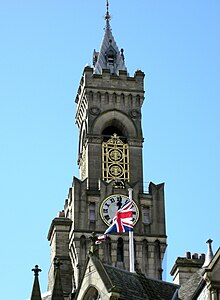
The Dom Tower of Utrecht is the tallest church tower in the Netherlands, at 112.32 metres (368,5 feet) in height. It is considered the symbol of Utrecht. The tower was part of St. Martin's Cathedral, also known as the Dom Church, and was built between 1321 and 1382, to a design by John of Hainaut. The cathedral was never fully completed due to lack of money. Since the unfinished nave collapsed in 1674, the Dom tower has been a freestanding tower. The tower stands at the spot where the city of Utrecht originated almost 2,000 years ago.

A carillon ( KERR-ə-lon, kə-RIL-yən) is a pitched percussion instrument that is played with a keyboard and consists of at least 23 bells. The bells are cast in bronze, hung in fixed suspension, and tuned in chromatic order so that they can be sounded harmoniously together. They are struck with clappers connected to a keyboard of wooden batons played with the hands and pedals played with the feet. Often housed in bell towers, carillons are usually owned by churches, universities, or municipalities. They can include an automatic system through which the time is announced and simple tunes are played throughout the day.

The Cathedral Church of All Saints, Derby, better known as Derby Cathedral, is a cathedral church in the city of Derby, England. In 1927, it was promoted from parish church status to that of a cathedral, creating a seat for the Bishop of Derby, which new see was created in that year. The original church of All Saints was founded in the mid-10th century as a royal collegiate church, dedicated to All Saints. The main body of the church as it stands today is a Georgian rebuilding by James Gibbs, completed in 1725. The tower dates from the 16th century, and a retroquire was added in the 20th century.
Campanology is the scientific and musical study of bells. It encompasses the technology of bells – how they are founded, tuned and rung – as well as the history, methods, and traditions of bellringing as an art.
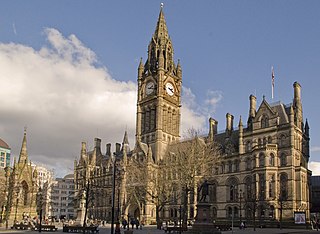
Manchester Town Hall is a Victorian, Neo-gothic municipal building in Manchester, England. It is the ceremonial headquarters of Manchester City Council and houses a number of local government departments. The building faces Albert Square to the north and St Peter's Square to the south, with Manchester Cenotaph facing its southern entrance.

A bell is a directly struck idiophone percussion instrument. Most bells have the shape of a hollow cup that when struck vibrates in a single strong strike tone, with its sides forming an efficient resonator. The strike may be made by an internal "clapper" or "uvula", an external hammer, or—in small bells—by a small loose sphere enclosed within the body of the bell.

The Burton Memorial Tower is a clock tower located on Central Campus at the University of Michigan in Ann Arbor at 230 North Ingalls Street. Housing a grand carillon, the tower was built in 1936 as a memorial for University President Marion Leroy Burton. This carillon is the world's fourth-heaviest, containing 53 bells and weighing a total of 43 tons.
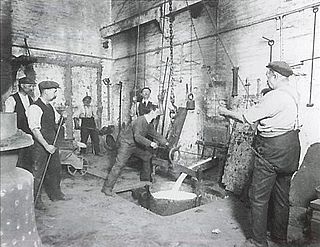
Gillett & Johnston was a clockmaker and bell foundry based in Croydon, England from 1844 until 1957. Between 1844 and 1950, over 14,000 tower clocks were made at the works. The company's most successful and prominent period of activity as a bellfounder was in the 1920s and 1930s, when it was responsible for supplying many important bells and carillons for sites across Britain and around the world.
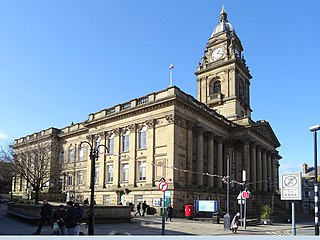
Morley Town Hall is a municipal facility in Morley, West Yorkshire, England. The town hall, which is the meeting place of Morley Town Council, is a Grade I listed building.

A chime or set of chimes is a carillon-like instrument, i.e. a pitched percussion instrument consisting of 22 or fewer bells. Chimes are primarily played with a keyboard, but can also be played with an Ellacombe apparatus. Chimes are often automated, in the past with mechanical drums connected to clocks and in the present with electronic action. Bellfounders often did not attempt to tune chime bells to the same precision as carillon bells. Chimes are defined as specifically having fewer than 23 bells to distinguish them from the carillon. American chimes usually have one to one and a half diatonic octaves. According to a recent count, there are over 1,300 existing chimes throughout the world. Almost all are in the Netherlands and the United States, with most of the remainder in Western European countries.

The National War Memorial of New Zealand is located next to the Dominion Museum building on Buckle Street, in Wellington, the nation's capital. The war memorial was dedicated in 1932 on Anzac Day in commemoration of the First World War. It also officially remembers the New Zealanders who gave their lives in the South African War, World War II and the wars in Korea, Malaysia and Vietnam.

Portsmouth Guildhall is a multi-use building in the centre of Portsmouth, UK, located on a pedestrian square close to the Portsmouth and Southsea railway station. Constructed in 1890, the building was known as Portsmouth Town Hall until 1926. It was heavily damaged by bombing during the Second World War and largely rebuilt during the 1950s by the English architect Ernest Berry Webber. It now operates as a concert, wedding and conference venue. It is a Grade II listed building.

Pieter Hemony and his brother François Hemony were the greatest bellfounders in the history of the Low Countries. They developed the carillon, in collaboration with Jacob van Eyck, into a full-fledged musical instrument by casting the first tuned carillon in 1644.

Leeds Town Hall is a 19th-century municipal building on The Headrow, Leeds, West Yorkshire, England. Planned to include law courts, a council chamber, offices, a public hall, and a suite of ceremonial rooms, it was built between 1853 and 1858 to a design by the architect Cuthbert Brodrick. With the building of the Civic Hall in 1933, some of these functions were relocated, and after the construction of the Leeds Combined Court Centre in 1993, the Town Hall now serves mainly as a concert, conference and wedding venue, its offices still used by some council departments. It was designated a Grade I listed building in 1951.
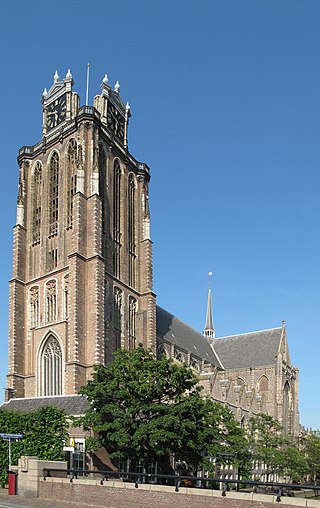
The Grote Kerk of Dordrecht, officially the Church of Our Lady is a large church in the Brabantine Gothic style, and the largest church in the city. It was built between 1284 and 1470, though some parts are newer. It became a Protestant church in 1572, and remains an active church, now owned by the Protestant Church in the Netherlands.

The Waag building is a National monument (Rijksmonument) listed building on the Waagplein in Alkmaar in the Netherlands. On this square Waagplein every Friday from April till the second week of September, the famous cheese market is held. The Dutch Cheese Museum and the tourist information Office (VVV) are also in the building. In the tower is a famous carillon weekly played by a carillonneur and also automatically by a drum chiming the quarters of the hour. There is also the famous automatic horse with knights play in the tower with an automatic trumpetplayer.
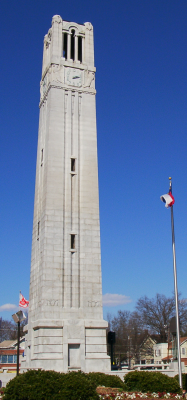
The North Carolina State University Memorial Belltower is a 115-foot-tall (35 m) free-standing bell tower on the Main Campus of North Carolina State University in Raleigh, North Carolina Conceived as a war memorial to honor university alumni killed in World War I and the university's overall participation in the conflict, the Belltower now serves as a perpetual memorial for N.C. State students and alumni who gave their lives in the service of the nation. A prominent university symbol, the tower is a popular rallying point for the campus community.

Evesham Bell Tower is the freestanding belfry for the town of Evesham, Worcestershire. Originally founded in 1207 by Adam Sortes, the present tower, the fourth to stand on the same site, was founded and built by Clement Lichfield, Abbot of Evesham as the bell tower for Evesham Abbey in the 16th century. It is the only part of the abbey complex to survive wholly intact.

Wakefield Town Hall is a municipal building in Wood Street in Wakefield, West Yorkshire, England. It remains a venue for weddings and civil partnerships but is no longer the headquarters of Wakefield Council which is now based at County Hall. The town hall is a Grade I listed building.
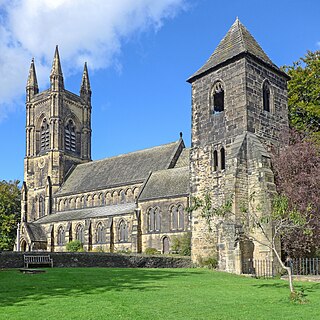
St Mary's Church is the parish church of the town of Mirfield in West Yorkshire, England. The current building is a large Gothic Revival structure designed by Sir George Gilbert Scott, replacing an older structure, the tower of which still survives a short distance from the present building. These structures form Mirfield's most prominent landmark and both are listed for preservation by Historic England, the old church tower as Grade II and the present building as Grade II*.



